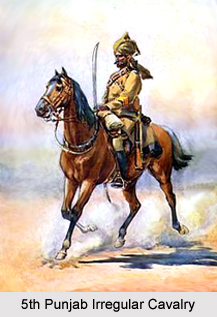 The 5th Punjab Irregular Cavalry was an erstwhile cavalry regiment of the British Indian Army. It was also known as the 25th Cavalry (Frontier Force) regiment. The former battalion was established as an armed force of the British East India Company by Captain Robert Fitzgerald as the 5th Punjab Cavalry in the year 1849 at Multan. The regiment was a part of the military force that seized at Delhi and also participated in the Relief of Lucknow. A single squadron of the 5th Punjab Irregular Cavalry fought at Bareilly and 2 Indian officers were awarded Order of British India and nine army personnel in other ranks were granted the Indian Order of Merit.
The 5th Punjab Irregular Cavalry was an erstwhile cavalry regiment of the British Indian Army. It was also known as the 25th Cavalry (Frontier Force) regiment. The former battalion was established as an armed force of the British East India Company by Captain Robert Fitzgerald as the 5th Punjab Cavalry in the year 1849 at Multan. The regiment was a part of the military force that seized at Delhi and also participated in the Relief of Lucknow. A single squadron of the 5th Punjab Irregular Cavalry fought at Bareilly and 2 Indian officers were awarded Order of British India and nine army personnel in other ranks were granted the Indian Order of Merit.
Military Operations of 5th Punjab Irregular Cavalry
The 5th Punjab Irregular Cavalry took part in several minor military operations and campaigns on the North West Frontier of India, where it served as a part of British India. In March 1860, the 150 troops of the unit fought against 3,000 soldiers of Mahsuds and Waziris at Tank. The unit later fought with tribesmen in January 1867. The 25th Cavalry (Frontier Force) regiment also took part in the capture of Charasiah during the Second Anglo Afghan War. Later it was sent to Kabul, along with 9th Lancers, under the command of Frederick Roberts.
In December 1879, Captain William John Vousden led the 5th Punjab Irregular Cavalry, also known 5th Regiment of Cavalry, Punjab Irregular Force, during the attack on the Asmai Heights, near Kabul. Captain John Vousden and nine other surviving members of the troops were awarded the Indian Order of Merit for their service. The 25th Cavalry (Frontier Force) provided military service during the Third Afghan War in 1919 and was stationed in German East Africa during the First World War.
Designations of 5th Punjab Irregular Cavalry
The 5th Punjab Irregular Cavalry of the British Indian Army maintained many titles through out the regrouping of the army. These are listed as follows -
* 5th Punjab Irregular Cavalry - 1849
* 5th Regiment of Cavalry, Punjab Irregular Force - 1851
* 5th Regiment of Punjab Cavalry, Punjab Frontier Force - 1861
* 5th Punjab Cavalry - 1901
* 25th Cavalry (Frontier Force) - 1903



















